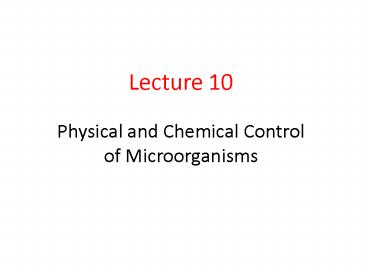Physical and Chemical Control of Microorganisms - PowerPoint PPT Presentation
1 / 30
Title:
Physical and Chemical Control of Microorganisms
Description:
Lecture 10 Physical and Chemical Control of Microorganisms * * * * * * * * History First microbial control practices developed by Ignatz Semmelweis in 1800s Some ... – PowerPoint PPT presentation
Number of Views:406
Avg rating:3.0/5.0
Title: Physical and Chemical Control of Microorganisms
1
Lecture 10
- Physical and Chemical Control of Microorganisms
2
History
- First microbial control practices developed by
Ignatz Semmelweis in 1800s - Some techniques developed
- Hand washing with chloride of lime
- Aseptic technique during surgery
3
Microbial Control
- Sterilization removal or destruction of all
forms of microbial life - Disinfection aimed at destroying harmful
microorganisms - Antisepsis disinfection directed at living
tissue - Degerming mechanical removal of most of the
microbes in an area - Sanitation intended to lower microbe counts to
safe public health levels
4
Rate of Microbial Death
- When bacterial populations are heated or treated
with antimicrobial agents they die at a constant
rate - Factors influencing the effectiveness of
microbial treatments - of microbes
- Environmental influences
- Time of exposure
- Microbial characteristics
5
(No Transcript)
6
Physical Methods of Microbial Control
7
Physical methods of microbial control
- Heat
- Filtration
- Refrigeration
- Radiation
- Dessication
- Osmotic Pressure
8
Heat
- Kills microbes by denaturing their enzymes
- Thermal Death Point
- Thermal Death Time
- Three types
- Moist heat, Pasteurization, Dry Heat
9
Moist Heat
- Denatures proteins
- Boiling kills bacteria, viruses, fungi and their
spores within 10 minutes - Endospores and some viruses are not easily killed
- Autoclave uses steam under pressure
10
(No Transcript)
11
Pasteurization
- High temperature used for a short period of time
to destroy pathogens without altering the flavor
of the food
12
Dry Heat Sterilization
- Flaming- heat wire to red glow
- Hot-air sterilization- place items in oven-
temperature 170oC for 2 hours ensures
sterilization
13
Filtration
- Passage of a liquid or gas through a filter with
pores small enough to retain microbes - Microbes can be removed from air by
high-efficiency particulate air filters - Membrane filters are commonly used to filter out
bacteria, viruses, even large proteins from
liquids
14
(No Transcript)
15
Refrigeration
- Different types of bacteria have optimum growth
temperatures - Those that are infectious to humans generally
grow best at human body temperature - By putting something in fridge you are slowing
the growth of these organisms
16
Radiation
- Effects of radiation depend on wavelength,
intensity, and duration - Ionizing Radiation- ionizes water, forms highly
reactive hydroxyl radicals - Non-ionizing Radiation- UV light damages DNA
- Microwaves- do not have much effect on
microorganisms
17
Dessication
- Dessication absence of water
- Microorganisms cannot grow or reproduce but can
remain viable for years - Viruses and endospores can generally resist
desiccation
18
Osmotic Pressure
- Microorganisms at high concentrations of salt and
sugars undergo plasmolysis - Molds and yeasts are more capable than bacteria
of growing in materials with low or high osmotic
pressure
19
Chemical Methods of Microbial Control
20
Antiseptics and Disinfectants
- The agent should be able to
- Kill or slow growth of microbe
- Non-toxic to humans and animals
- Soluble in water, good shelf life
- Useful in diluted form
- Able to perform job in short time
21
Antiseptics and Disinfectants
- Several parameters should be considered
- Temperature
- pH
- Stability
22
Halogens
- Oxidize proteins
- Examples Chlorine and Iodine
23
Phenol and Phenolics
- Denature Proteins
- Phenol- strong odor caustic to skin
- Phenolics used more often
24
Heavy Metals
- Interfere with microbial metabolism
- Believed to bind protein molecules, making them
unusable
25
Alcohols
- Denature proteins and disrupt membranes
- Preferred alcohol- ethyl alcohol
26
Soaps and Detergents
- Act as surface active agents
- Not bacteriocidal
27
Hydrogen Peroxide
- Breaks down into toxic form of oxygen
- Not good on open wounds
28
Antiseptics in your pantry
- Cinnamon
- Garlic
- Honey
- Wasabi
29
(No Transcript)
30
Figure 7.11































